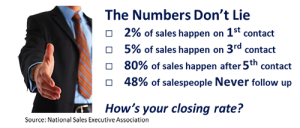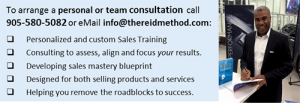7 Steps to Improve your Closing Ratio and Win Long Term Clients
Many sales people truly hate the follow-up process and most fail at it miserably!
In fact this has been studied to death and there are endless amounts of sales and follow-up stats to prove how and why a sales person fails or excel in sales. Many sales are lost right here because the average salesperson or 48% do not conduct a follow-up call or email at all. For me there are really three categories of sales people;
- The bottom 5% or “the reactors”. Poor performers lack focus, drive and simply wait for instructions from the boss or prospects to call or visit. They simply put in their time and wait all day instead of creating opportunities.
- Everybody else – up to 79% are “average salespeople”. They make up the bulk of most sales teams. Most lack confidence in their abilities, and rarely follow-up with a client more than four times after the initial inquiry. They put in more time and effort but often it’s busy repetitive work. Unfortunately, 80% of sales staff contribute less than half the sales or results.
- Top performers, or the top 20%, produce 50%-80% of sales by sifting through the noise that doesn’t matter. They delegate when necessary and have laser like focus on results. They know the magic formulas to sales success including that meaningful and consistent follow-up between 5-12 times pays off. My previous blog showed that they make 5X the average sales person and often more than their managers. https://www.thereidmethod.com/make-5x-the-average-income-in-automotive-sales-seven-success-tips/

- SET STRETCH GOALS AND TARGETS; top performers set higher goals and targets, first and foremost. Never wait to be told or asked to follow-up with clients or to sell a certain number of cars, products or services. Top performers have daily follow-up goals and aim to make progress with every follow-up.
- MONITOR OBJECTIVES, the 24hr Follow-up Rule; this doesn’t have to be a lot of work and could be as simple as an email to confirm next steps, a call to review key details, or expected outcomes. Following up within twenty-four hours of a sales call or meeting is a must, unless you’ve agreed on a different timeframe with the prospect.
- FOLLOW-UP METHODS VARY; including email, phone call, text, letters, social media and in person. Find creative ways to build your relationship and trust with clients while getting past five contacts— the minimum necessary to close most deals.
- FILL YOUR PIPELINE; “Always be closing” is a popular maxim in sales. I say you should always be following-up and prospecting. This keeps the pipeline flowing and minimizes the highs and lows of sales. Top performers often set aside prospecting time aside every day.
- BE A TRENDSETTER; take initiative that co-workers ignore to get ahead. Lead by results-oriented examples it’s easier to achieve after you’ve demonstrated results. If your follow-up style or methods are more meaningful, and relevant to your audience the chances of progress and closing increases dramatically.
- NETWORK, NETWORK, NETWORK; Top performers are people-oriented and possess strong networking and relationship-building skills. They are confident so reaching out is really no big deal. They tend to turn a basic follow-up into a networking opportunity with the ability to collaborate with others even including potential clients.
- BE OPEN-MINDED; to follow-up effectively and successfully you must be open minded. Good follow-up skill includes being able to compromise and be open-minded. A top performer will change tactics when the time is right, avoid being stubborn. Flexibility helps top performers adapt and become excellent problem solvers. After all, sales is about overcoming objections and problem solving.

Sign-up for my weekly blog @ www.thereidmethod.com/blog and check out my Blueprint for Achieving Sales Mastery book, The Reid Method available in eBook https://www.amazon.ca/Reid-Method-Blueprint-Achieving-Mastery
Recent Comments